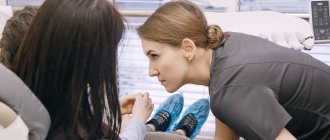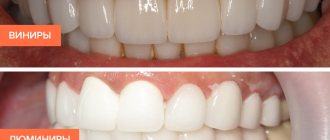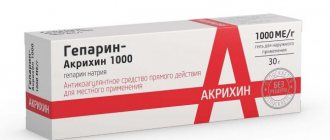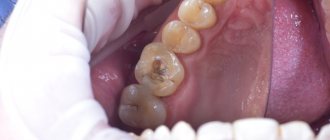Primary teeth are necessary so that, under the influence of occlusal load, a sufficient amount and volume of bone tissue is formed. Otherwise, permanent teeth simply would not be able to take root in the gums. Normally, a child's teeth are replaced in a certain order. As a result, the primary bite is replaced by a permanent one without pathologies.
Removal (extraction) of baby teeth only at first glance seems to be an absolutely simple procedure. If a baby tooth is lost long before a permanent tooth grows in its place, there is a risk of developing pathological changes in the bite. The decision to remove a child’s tooth must be made by a doctor.
Indications for tooth extraction in children
The absolute indications for the removal of baby teeth are:
- Neoplasms (cyst, phlegmon).
- Damage to the tooth with further development of a fistula.
- Severely advanced caries, as a result of which the crown of the tooth is completely destroyed.
- Chips and carious lesions in the crown of the tooth result in the formation of a sharp edge that injures the mucous membrane.
- Inflammation of the tissues adjacent to the tooth.
- The permanent tooth has already begun to erupt and the milk tooth interferes with it.
What to do if you had to remove several baby teeth?
If premature removal of a baby tooth is inevitable in a child, then dentures are necessary. Most often these are removable plates with an artificial tooth. For large losses, doctors install crowns made of plastic or metal. This is necessary in order to prevent displacement of the dentition. And then new teeth will grow in the right place.
Contraindications
It is not recommended to remove a child’s baby teeth in the following cases:
- Severe chronic conditions (heart defects, epilepsy, etc.).
- Inflammation in the oral cavity (stomatitis, gingivitis).
- Problems with blood clotting.
- Infectious diseases in the acute phase (ARVI, influenza, scarlet fever, chickenpox, etc.).
If there are contraindications, tooth extraction can be dangerous. But not all contraindications are absolute. For example, if the baby has an inflammatory process or an infectious disease, the tooth can be removed after treatment. The final decision about the procedure will be made by the dentist.
Removal without pain
In pediatric dentistry, it is very important to ensure the child’s comfort during the tooth extraction procedure. This applies to all stages of treatment. To prevent the baby from being afraid, double anesthesia is used:
- Anesthetic gel. It is necessary to reduce the sensitivity of the gums and prepare for further anesthesia.
- Injection anesthesia. After the gel begins to take effect, the nurse will inject an anesthetic into the gum. Thanks to the action of the gel, the child does not feel pain from the injection.
Many drugs for local anesthesia, which are used to anesthetize tooth extraction, are strong allergens. In order to exclude the possibility of an allergy, the child is given a skin test.
Features of milk teeth removal
Milk teeth have their own characteristics:
- Thin alveolar walls.
- Weak, poorly defined neck.
- Divergence of roots in different directions.
To remove teeth, forceps with a slight fixation are used. The doctor grabs the crown with forceps, turns the tooth inside out and removes it from the socket. After this, the hole must be carefully inspected. Due to the structural features of baby teeth, there is a risk that part of the root or crown will remain in the socket. If everything is normal and there are no fragments in the hole, a sterile swab will be placed on the child’s wound. This helps stop bleeding faster and protects the wound.
The extraction procedure is quick. Thanks to double anesthesia, the baby does not feel pain at all. Removal is comfortable, without pain and fear.
How do the roots of baby teeth dissolve?
The process of replacing children’s teeth with “adult” ones normally occurs at the age of 5-7 years. It is during this period of life that a person first becomes partially toothless. But before the first incisor falls out, serious physiological changes will occur in the structure of its roots. We are talking about the process of resorption, better known under the term “resorption”. Let's look at how this happens.
First, the hard plate that separates the germ of a permanent tooth and the roots of a milk tooth begins to collapse. Small pits with osteoclasts form inside the roots. The roots located near the bud are the first to disappear. The process always starts from the apex and moves towards the gum.
Soon, the loose fibrous connective tissue located inside the crown is replaced by granulation tissue. The latter is also important for timely resorption. After this, very little time passes before the tooth begins to become very loose and one day falls out. A permanent unit is soon shown in the vacated space.
In most cases, resorption proceeds in balance with the eruption of permanent teeth, but sometimes failures occur. Then the roots of children's baby teeth are preserved for a long time or, conversely, are destroyed much earlier than expected. Such phenomena are undesirable.
Forced resorption occurs due to traumatic injuries, tumor growths, strong pressure from “neighbors,” deep bite, and orthodontic disorders. A slowdown in the process is possible if there are no rudiments at all.
Thus, children have roots of baby teeth. They are simply subject to resorption. That is why they cannot be seen by the time they fall out.
Care after removal
In order for the wound to heal normally, you need to follow the recommendations for caring for your teeth after extraction. An infection can easily penetrate through an unhealed wound, which means that without care there is a risk of developing inflammation.
Caring for your child’s oral cavity is very simple:
- Immediately after removal, it is important to prevent the blood clot from being washed out of the socket. Therefore, the child should not eat or drink anything.
- The wound should be protected as much as possible from the risk of infection. You can't touch it with your hands. You need to make sure that the baby does not touch the hole. Penetration of infection can lead to the development of inflammation, suppuration and other complications.
- The first three days you need to do mouth baths. You can use medications that your surgeon recommends. Suitable decoctions of herbs with antiseptic and anti-inflammatory properties - sage, chamomile.
- The child’s diet should be monitored for the first five days. You should not eat solid food, cold and hot drinks, or confectionery.
If you follow these simple rules, a child almost never experiences complications after the removal of a baby tooth. In case of infection, you should immediately show the child to a doctor. You should come for examination if the following symptoms appear:
- Continuous bleeding. After removal of a dental unit, the wound may bleed for several hours. If the bleeding does not stop, you should consult a doctor.
- Bad breath. It may be a sign of developing inflammation or suppuration. The inflammatory process quickly spreads to other tissues, which can cause serious complications.
- Fever. Speaks of infection or inflammatory process. Immediately after surgery, your temperature may rise slightly. This is often due to the stress that the child experiences in the dental chair. If the temperature persists for a long time or rises during the healing process, you cannot delay a visit to the dental clinic.
Types of injuries
Dental injuries vary in severity and possible consequences for the body.
Injury
The hard tissues of the tooth, as well as its position in the arch, remain intact, but upon impact, the soft tissues and ligaments that hold the tooth in the socket are injured. Swelling of the gums may develop, and it will be painful for the child to bite into food. If the pulp is not damaged, the tooth will recover on its own within 3–4 weeks of a special “soft” diet.
Dislocation
A complete dislocation is considered if a child knocks out a baby or permanent tooth. In this case, the tooth leaves the socket, but it can be straightened and returned to its place. How successful the healing of a lost tooth will be depends on the preservation of the roots, the absence of inflammatory processes, the speed of replantation and compliance with subsequent recommendations of the dentist. More often, in the event of an impact, temporary teeth completely leave the jaw - they have small roots and movable ligaments. Parents have only a few hours to return the tooth to its place with minimal loss. If more time has passed, most likely the tooth will no longer take root. Dislocation can also be incomplete, when the ligamentous apparatus of the tooth is partially damaged and its position changes. In this case, swelling occurs and bleeding often occurs. Only a doctor can correctly set a dislocated tooth. Without proper attention from specialists, an injured tooth with damaged ligaments may forever remain in the unphysiological position it occupied after the impact. If a lot of time has passed since the injury, an orthodontist will help the luxated tooth. Special plates with a calculated directed pressure force, made individually, will help the tooth return to its original position even after many years.
With complete luxation, the tooth completely falls out of the socket. It is important to see a dentist as soon as possible, minutes count. I repeat: replantation can only be carried out on permanent teeth; this cannot be done on milk teeth! Replantation is contraindicated:
- with extensive carious destruction of the tooth crown,
- with severe periodontal disease,
- for general somatic diseases and reduced immunity.
Selyutina Yu. I., member of the international association of pediatric dentists IAPD, winner of the federal competition of pediatric dentists of Russia, pediatric dentist, writer, blogger, founder of the author's Center for Dentistry[3]
Crack
With a minor impact, damage can only affect the enamel - it can chip or break. Cracks can be so insignificant that they are not even detectable during visual inspection. It is necessary to use special optical devices or a fiber-optic LED for transillumination examination. There is no special treatment for cracks.
Fracture
There are cases when a child has partially knocked out a permanent tooth. If part of the tooth remains in the tissues, and part is lost, this is a fracture. It can be transverse, oblique, longitudinal or splintered. Depending on the trajectory of the impact or fall, both the crowns of the teeth and their roots are susceptible to fractures. Most often, in 67.8% of cases, crowns break when permanent teeth are injured. The prognosis of treatment will depend on the location of the damage and whether the tooth cavity has been opened [1, 4].
How does removing baby teeth affect your bite?
Removing baby teeth can be dangerous for the bite if the permanent teeth have not yet begun to emerge. The prolonged absence of a dental unit leads to the fact that neighboring ones begin to move, filling the empty space. When permanent teeth begin to emerge, they run out of space. This leads to the development of various bite defects.
When removal cannot be avoided, it is recommended to install special artificial crowns. This way you can avoid tooth movement and changes in your bite.
In addition to the risk of developing malocclusion, early removal of baby teeth may have other consequences:
- Articulation impairment. Because of this, speech defects often form, which can become a barrier to communication with others. Communication with peers is very important for a child. Problems due to speech defects can be a harbinger of psychological disorders.
- Digestive problems. Due to the lack of teeth, chewing becomes difficult and the process of processing food in the oral cavity is disrupted. Chewing is an important step in the digestion process. Its violation can lead to the development of gastrointestinal diseases.
You cannot remove baby teeth yourself, even if they are mobile. Extraction is a surgical procedure. An experienced specialist should remove teeth.
The Zuub.rf clinic has a children's department. Pediatric dentists and surgeons work here. The operation will be comfortable and completely safe for your baby.
How to extract a baby tooth from a child at home
So, we come to the most age-old question for many parents. And the answer to it is ambiguous. On the one hand, when a child’s baby tooth becomes loose, it usually falls out spontaneously, without causing pain or discomfort to the baby. On the other hand, if parents are so eager to take an active part in this process, then they should remember that:
- Children should not be allowed to chew on solid food: apples, carrots, crackers. This can damage the gum tissue.
- You should not try to remove a tooth when the child is crying and resisting. This will cause psychological trauma to your child.
- You cannot remove a tooth using improvised, non-sterile means. You can get an infection in your mouth.
- You cannot put pressure on the tooth or tilt it. This will cause pain to the child and damage the gums.
In addition, risks such as incomplete tooth extraction (when fragments remain in the gum), root fracture, injury to neighboring teeth and bone tissue, damage to the nerve and gums - when removing a tooth at home, increase many times over. In this case, you, as a non-specialist, cannot guarantee that everything will go smoothly and safely.
Therefore, do not waste your time on barbaric and long-outdated methods of removing baby teeth with unpredictable consequences: save your nerves and the health of your child! Make an appointment with a pediatric dentist, where, under sterile conditions, a knowledgeable, experienced doctor, in a cozy office, while showing cartoons, will quickly and painlessly remove the desired baby tooth.











